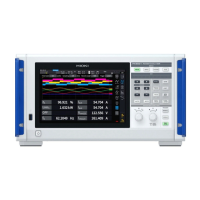59
Measuring Power
• The same synchronization source will be set for each channel’s voltage and current.
• The same synchronization source will be used for each channel’s harmonic measurement.
Note, however, that if [Zph1] is selected as the synchronization source and [Ext1] is selectable,
either [Ext1] or [Zph1] is selectable as the synchronization source for harmonic measurement.
When [Zph3] is selected and [Ext3] is selectable, either [Ext3] or [Zph3] is selectable as the
synchronization source for harmonic measurement.
• For channels measuring AC current, select an input with the same frequency as the measured
signal’s frequency as the synchronization source. If the frequency of the signal selected as the
synchronization source diers signicantly from the measured signal’s frequency, the instrument
may display a frequency that diers from the input, and measured values may become unstable.
• Segments for which [DC] has been selected will be matched with the data refresh interval. (10 ms,
50 ms, 200 ms)
• If AC input is measured using the [DC] setting, the displayed values may uctuate, making
accurate measurement impossible.
• If a frequency lower than the measurement lower frequency limit setting or higher than the
measurement upper frequency limit setting is inputted as the synchronization source while the
synchronization source is set to a setting other than [DC], the instrument may display a frequency
that diers from the input, and measured values may become unstable.
• Selecting [Ext] makes it easier to achieve synchronization when the motor’s RPM varies over
short periods of time, making it useful in power analysis.
See “Measuring the electric angle of the motor” (p. 91).
• When you select [Zph.], you can perform harmonic analysis based on one motor revolution (one
cycle of the mechanical angle).
• The zero-crossing interval cannot be acquired when the synchronization source for a channel
to which DC is being input is set to voltage or current. The instrument will operate with a
synchronization frequency equivalent to approximately one period of the measurement lower
frequency limit.
• Synchronization unlock may occur for frequencies lying close to the measurement lower
frequency limit setting, causing measured values to become unstable.
• By inputting a pulse signal to Ch. B, Ch. D, Ch. F, or Ch. H of the instrument with the motor
analysis and selecting Ch. B, Ch. D, Ch. F, or Ch. H, respectively, as the synchronization source,
you can set the measurement timing as desired. Note that the rising edge of the input pulse is
detected for Ch. B, Ch. D, Ch. F, and Ch. H.
Synchronization-unlocked condition
Channels that cannot be synchronized to the synchronization source will fall into a synchronization-
unlocked condition, preventing accurate measurement.
Check synchronization source input.
A warning indicator will come on to indicate a synchronization-unlocked condition occurs.
See “Common screen display” (p. 23).
Displaying Power Numerically

